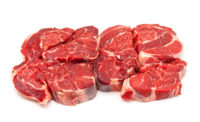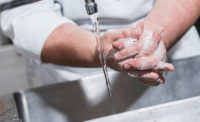The latest sanitation tools for meat and poultry have familiar names but, more importantly, increased interest.
“It takes time, in some cases, for the industry to use ‘new’ methods,” says Norman G. Marriott, PhD, emeritus professor, Virginia Tech in Blacksburg.
One of the more recent innovative techniques for sanitizing equipment would be a delivery system where a conveyor contains nozzles that spray sanitizers on it or on containers after product has traveled on it -- similar to clean-in-place equipment, notes Marriott.
“If spray nozzles work well, they will be used by more companies,” says Marriott. “The cons against spray nozzles would be cost, maintenance issues – it’s one more thing to worry about – and increasing worker vulnerability to chemicals during production or cleaning.”
According to Orsi Dézsi, business lead, food safety – equipment & chemical evaluation at National Sanitation Foundation (NSF) International, Ann Arbor, Mich., ultraviolet sanitizing stations have significantly increased.
“Robotic integration into food assembly [has increased] to reduce time/human touch points such as automated pizza assembly/cooking systems, in addition to integration of touchless design components and use of antimicrobial surface treatments and materials on high touch surfaces,” says Dézsi.
In commercial foodservice, there has been an increase in refrigerated/heated Amazon-style “lockers” to address the increase in online ordering/pick-up at grocery chains and quick service restaurants, “and a shift to complete robotic fast casual kitchens integrated within malls and other high traffic areas to reduce human contact and deliver more variety at reduced price points,” says Dézsi.
Evaluating sanitizers
Sanitizers are also seeing increased interest in materials that have been around for years but not fully utilized, such as silver, hydrogen peroxide, ozone and organic acids, says Marriott.
“Overall, they can be efficient sanitizers,” says Marriott. “Ozone, however, is generated on-site so smaller processors won’t want to spend money on that. Also, there are some limitations for the use of hydrogen peroxide.”
More research is being carried out with hypochlorous acids, which are used to disinfect for COVID-19 in hospital settings, and dry steam.
“At NSF, we have seen a significant 10 percent increase in the registration of disinfectants and cleaners over the last year,” says Dézsi. “In the U.S., any product used in the field [chemical or device] making a kill claim must be registered with the EPA under FIFRA [Federal Insecticide, Fungicide, and Rodenticide Act], validating those claims.”
After animals are harvested, their carcasses are washed with a sanitizing compound. “Many interventions are used, but the most popular would be acetic acid sprays and hot water sprays, although they aren’t new,” says Marriott. “Lactic acid has also been around for years. It’s very effective but expensive.”
There have been some safety concerns raised about standard sanitizing agents, such as chlorine and sodium hypochlorite being possibly carcinogenic. But, says Marriott, “there is nothing definitive enough about the research to take them off the market. Any sanitizer in excess can be detrimental. Nothing is fail-safe.”
More research is still needed to identify the ultimate sanitizer based on cost and effectiveness versus potential hazards. “It can still be subjective to define effectiveness,” notes Marriott. “A good example of this is quats [quaternary ammonium compounds]. It’s quite effective against foodborne pathogens but not spoilage bacteria, and is expensive.”
As new product research evolves, it may become more common that the processing equipment itself will regularly be “cooked” and “soaked,” similar to products, to eliminate pathogens from all cracks and crevices. NP










